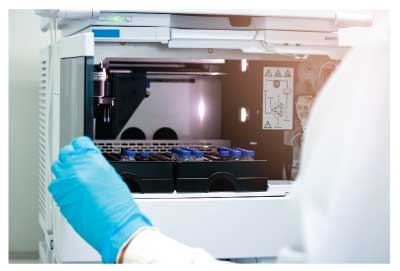HPLC is a Sort of Column chromatography having a broad assortment of applications in pharmaceuticals and analytical chemistry as an effective separation instrument. The column, which functions as the stationary phase plays an integral role in the separation of elements in HPLC. Stationary phases are often composed of polar or non-polar chemicals according to column type. Both polar or non-polar columns are utilized to separate compounds based on the nature of the chemical to be examined. The mobile phase is pumped into the machine with the support of pumps and the sample is introduced to the mobile phase using the injector. The pumps maintain a continuous flow rate of the mobile phase. Upon entering the column, components become separated according to their polarity depends upon the polarity of the stationary phase. If the column is non-polar then non-polar chemicals become connected to the column and polar compounds elute first to reach the sensor and vice versa.

A compound is Identified by calculating the retention period or Rt that is the time necessary for a specific compound to get to the sensor through the column following the injection is made. HPLC column efficiency is quantified using the theoretical plate Tp concept. There is absolutely not any physical plate within a column instead it is based on mathematical calculation. Theoretical plates in HPLC can be considered a hypothetical zone comprising two phases present in balance with one another. Columns with a greater number of theoretical plates are considered more effective compared to columns with the lesser amount of Tp. A pillar with more theoretical plates i.e. more efficient provides narrower peaks to the same compound compared to less effective columns. The theoretical plates could be calculated per meter length of this column. In accordance with USP or the United States Pharmacopoeia, the theoretical plate of a column is calculated with the following formula
N = 16Ve or Wbtwo
Where,
N is the theoretical plates
Ve is the retention time
Wb is the width of the peak
The determination of Tp should be made while keeping specific set requirements for all the test columns. Column temperature, in particular, plays an important role in Changing the theoretical plate number in a column. Retention factor or Rf ratio of the distance traveled by the part as well as the solvent of the evaluation Solute to be utilized for the conclusion of Tp of a column must always be Than 5 for a precise value of Tp. Therefore, while comparing the pillar Efficiency across columns the temperature and retention variable ought to be maintained same. Theoretical plates at HPLC column also depend on the mobile stage Viscosity, flow rate and molecular structure of this compound to be examined. what is hplc Mobile Phases comprising more percentage of water are more viscous compared to Those having the greater concentration of organic solvents. This is a reason to have lower Tp for columns during functional use when compared with the typical testing condition.